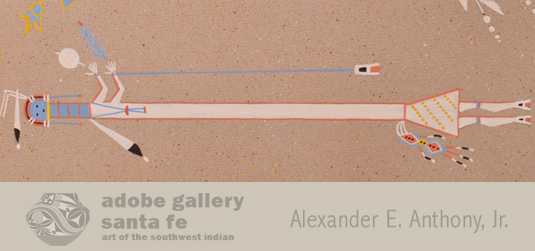Original Painting of Medicine Man and Sandpainting Imagery by Harrison Begay [SOLD]
+ Add to my watchlist Forward to Friend
- Category: Paintings
- Origin: Diné of the Navajo Nation
- Medium: watercolor
- Size:
27-¼” x 18-⅝” image;
31-⅜” x 22-¾” framed - Item # C4158B SOLD
The Medicine Man (or “hatali”) is a vital part of the Diné lifestyle. Chief among his duties are ceremonies which are performed to restore harmony (or “hohzo”) to a suffering patient’s mind, body or spirit. There are a variety of healing rituals, which depend on the patient’s symptoms, the causes of the problem and what the hatali deems the proper method to restore balance. These ceremonies can include prayers, chanting, cleansing with cedar smoke, drumming and the creation of sandpaintings. Sandpaintings are used to recreate ancient stories that are associated with spirit beings (or “Yeis”) who have struggled against evil and prevailed. The patient will become part of the story and call on the spirits to vanquish that which is causing their problems. After a physical and spiritual cleansing, balance will be restored.
![]() This painting by Harrison Begay provides a detailed look at a Diné medicine man’s practice, with an image that is divided into two parts: the physical in its bottom third, and the spiritual in its top two-thirds. The physical world—a medicine man and two children—is presented with Begay’s typical grace. The spiritual world, presented via the medicine man’s sandpainting imagery, is truly spectacular. In the center of the image is a circular design, from which four important resources emerge: beans, squash, corn, and tobacco. Their colors—blue, white, yellow, and black, respectively—correspond with those of the Four Directions and the Navajo creation story’s Four Worlds. Around this design are depictions of four Diné gods. Stretching around the gods and framing the painting’s spiritual world is a long, colorful Yei figure. A thin pair of white and purple lines separate the artist’s physical world from his sandpainting imagery. In what must have been a deliberate move by Begay, the painting is completed on paper that is the color of sand. In the areas surrounding the spiritual imagery, he added small dots in various colors, giving the “sand” a lifelike texture.
This painting by Harrison Begay provides a detailed look at a Diné medicine man’s practice, with an image that is divided into two parts: the physical in its bottom third, and the spiritual in its top two-thirds. The physical world—a medicine man and two children—is presented with Begay’s typical grace. The spiritual world, presented via the medicine man’s sandpainting imagery, is truly spectacular. In the center of the image is a circular design, from which four important resources emerge: beans, squash, corn, and tobacco. Their colors—blue, white, yellow, and black, respectively—correspond with those of the Four Directions and the Navajo creation story’s Four Worlds. Around this design are depictions of four Diné gods. Stretching around the gods and framing the painting’s spiritual world is a long, colorful Yei figure. A thin pair of white and purple lines separate the artist’s physical world from his sandpainting imagery. In what must have been a deliberate move by Begay, the painting is completed on paper that is the color of sand. In the areas surrounding the spiritual imagery, he added small dots in various colors, giving the “sand” a lifelike texture.
![]() This painting’s framing—wide, wooden frame without matting—works very well with the unique imacornge. The painting, which dates to the 1970s or 1980s, is signed Haskay Yahne Yah in lower left and Harrison Begay in lower right.
This painting’s framing—wide, wooden frame without matting—works very well with the unique imacornge. The painting, which dates to the 1970s or 1980s, is signed Haskay Yahne Yah in lower left and Harrison Begay in lower right.
Harrison Begay (1917-2012) Haskay Yahne Yah (The Wandering Boy) was a world-renowned Diné (Navajo) painter who is generally regarded as one of the most successful and influential early Native American painters. Begay studied under Dorothy Dunn at the Santa Fe Indian School in the 1930s, and then attended colleges in North Carolina and Arizona. From 1942 to 1945, he served in the US Army Signal Corps. In 1947, Begay returned to the Navajo reservation, where he enjoyed a long and productive career as a painter. He is known to have continued painting well into his 90s.
Condition: this Original Painting of Medicine Man and Sandpainting Imagery by Harrison Begay is in excellent condition
Provenance: from the large collection of a New Mexico resident who purchased it in the 1970s while living in Gallup, NM
Relative Links: Diné - Navajo, Harrison Begay, Dorothy Dunn, Native American Paintings

- Category: Paintings
- Origin: Diné of the Navajo Nation
- Medium: watercolor
- Size:
27-¼” x 18-⅝” image;
31-⅜” x 22-¾” framed - Item # C4158B SOLD



